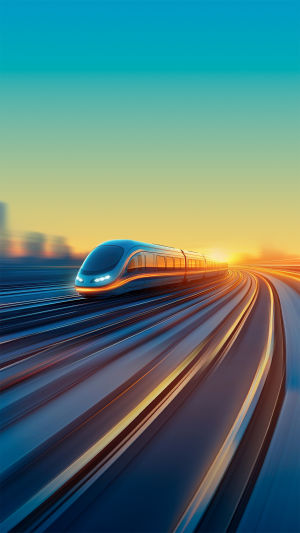The pursuit of the fastest trains has led to significant advancements in rail technology.
Engineers and innovators are continually pushing the limits of speed, sustainability, and design.
As of 2025, several high-speed trains have set new standards for speed and efficiency, revolutionizing rail travel around the world. Here’s a closer look at the top five fastest trains that are currently in operation!
<h3>1. Maglev L0 Series (Japan) – 374 mph (602 km/h)</h3>
Japan’s Maglev L0 Series is currently the fastest train in the world, having reached a top speed of 374 mph (602 km/h) during test runs. This train utilizes cutting-edge magnetic levitation (maglev) technology, which allows it to float above the tracks using powerful magnets, eliminating friction and allowing for much higher speeds compared to conventional trains.
Though it is not yet in commercial use, the Maglev L0 is expected to transform high-speed rail travel in the near future, with plans for its deployment on the Chūō Shinkansen route connecting Tokyo and Nagoya by 2027.
<h3>2. Shanghai Maglev (China) – 268 mph (431 km/h)</h3>
The Shanghai Maglev is the world’s fastest commercially operating train, reaching speeds of up to 268 mph (431 km/h). It connects Shanghai Pudong International Airport with Longyang Road Station, covering a distance of 18.6 miles in just 7 minutes.
This maglev train, operational since 2004, is a marvel of modern engineering, utilizing electromagnetic propulsion to minimize friction and provide an ultra-smooth ride. Despite being one of the oldest commercial maglev systems, it remains a prime example of how maglev technology can revolutionize urban transit.
<h3>3. Fuxing Hao CR400AF (China) – 249 mph (400 km/h)</h3>
The Fuxing Hao CR400AF, part of China train fleet, is one of the fastest trains operating on conventional tracks. It can reach speeds of 249 mph (400 km/h) and serves the Beijing–Shanghai High-Speed Railway, covering the 819-mile route in just over four hours.
The CR400AF is renowned for its advanced features, including energy-efficient systems, low noise levels, and smooth acceleration. It is designed with state-of-the-art aerodynamics to minimize air resistance, making it not only fast but also highly efficient. With its sleek design and reliability, it is a symbol of China’s progress in high-speed rail development.
<h3>4. TGV Lyria (France/Switzerland) – 199 mph (320 km/h)</h3>
The TGV Lyria connects major cities across France and Switzerland, including Paris, Geneva, and Lausanne, reaching speeds of 199 mph (320 km/h). The train is part of the high-speed TGV (Train à Grande Vitesse) network, known for its luxury and efficiency.
The TGV Lyria trains are equipped with comfortable interiors, including spacious seating and advanced onboard services. Serving international routes, this train has become an essential mode of travel for business and leisure between France and Switzerland. It offers both speed and comfort, cutting travel times significantly between cities like Paris and Geneva.
<h3>5. Al Boraq (Morocco) – 200 mph (320 km/h)</h3>
The Al Boraq, Africa's first high-speed train, began operations in 2018, connecting Casablanca and Tangier at speeds of up to 200 mph (320 km/h). This modern rail service reduced the journey time between these two cities from over five hours to just under two hours, significantly boosting regional connectivity.
The Al Boraq project represents Morocco’s ambitious push to modernize its infrastructure and support economic growth. Designed with state-of-the-art technology, the train offers a comfortable and efficient ride, symbolizing Africa's growing investment in high-speed rail systems.
The fastest trains in the world not only demonstrate the incredible pace at which rail technology is advancing but also highlight the broader impact on transportation and connectivity. From Japan’s futuristic Maglev L0 to Morocco’s pioneering Al Boraq, these trains are setting new standards for speed, efficiency, and sustainability. As countries invest more in rail infrastructure, these record-breaking speeds could soon become the norm, promising a faster and more connected future for global travel!





